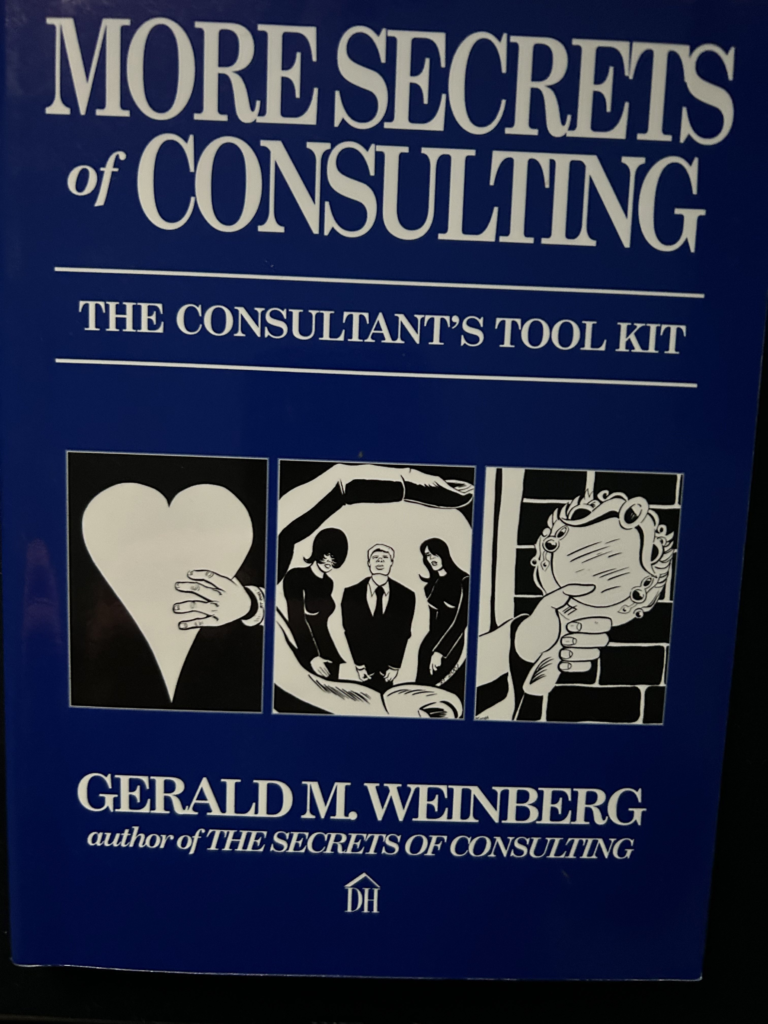It’s been four years since – sadly – Gerald M. “Jerry” Weinberg passed away. Ever since then, I struggled with some public mourning about him, until recently I had just the right idea. On a weekly basis, I will publish a review of a book I read that Jerry either wrote himself or is about some of his work. Today, we continue the topic of consulting as I picked More Secrets of Consulting – The Consultant’s Tool Kit published by Dorset House in 2002.

More Secrets of Consulting builds on Jerry’s Secrets of Consulting, yet, can be read stand-alone, I suppose. What I recall vividly from this second consulting book is the courage stick and the Law of Strawberry Jam:
The Law of Strawberry Jam
page 3
As long as it has lumps, you can never spread it too thin.
as opposed to the Law of Raspberry Jam stemming from his earlier book:
The Law of Raspberry Jam
page 2
The wider you spread it, the thinner it gets.
Jerry had a particular model throughout his book depicted with several icons. He introduces it as Virginia Satir’s tool kit consisting of 16 elements:
- The Wisdom Box: the ability to know what’s right and what’s not right for me.
- The Golden Key: the ability to open up new areas for learning and practicing, and to close them if they don’t fit for me at this time.
- The Courage Stick: the courage to try new things and to risk failure.
- The Wishing Wand: the ability to ask for what I want, and if necessary, to live with not getting it.
- The Detective Hat: the ability to examine data and to reason about those data.
- The Yes/No Medallion: the ability to say yes, the ability to say no (thank you), and the ability to mean what I say.
- The Heart: the ability and willingness to put my heart into my work.
- The Mirror: the ability to see myself and to seek and use feedback.
- The Telescope: the ability to others and to bring them closer to my understanding than my naked brain and eye can manage.
- The Fish-Eye Lens: the ability to see the context, what surrounds me and others and influences us as we work together.
- The Gyroscope: the ability to be balanced to use all of my tools, and to be congruent and centered.
- The Egg: the ability to grow, develop and learn, using all the parts of myself that I need.
- The Carabiner: the ability to ensure my safety and to not take unnecessary risks.
- The Feather: the ability to tickle myself and others, and to not take myself or others too seriously.
- The Hourglass: the ability to make time for the good and to make good use of time.
- The Oxygen Mask: the symbol for a balanced life.
Each chapter in the book is dedicated to one of these 16 tools for the consultant toolbox.
Just reading through the description of the 16 tools in the consultant’s tool box makes me reflect on my past consultant and non-consultant life, and consider re-reading Jerry’s more secrets of consulting. The mindful eye probably has caught Satir’s congruent communication model in the 16 tools as well as Jerry’s open considerations for getting balance into his consultant’s life.
Among the lessons I cross over while skimming through the book, I find a particular reference to Lullaby Language in there. Terms like “always”, “never”, etc. hint at some kind of lullaby language being present. I found a recent example at a client. As winter approaches here in Western Europe, and we start to heat not only our homes but also our offices, the front door greeted me one morning with “Please always keep the door closed.” My remark “But I can’t enter or exit the building if I keep the door always closed” received a to-be-expected eye-rolling reaction, though.
As I work through re-visiting Jerry’s More Secrets of Consulting for this review, I sense the urge to re-read both his consultant’s books. I hope my just brief thoughts here may have you conclude similarly.
Some personal gem
Similar to the Quality Software Management series, I created a document with a listing of rules, laws, and principles from the consulting series of books for my own reminders and easier reference. Typos are mine, not necessarily Jerry’s.




